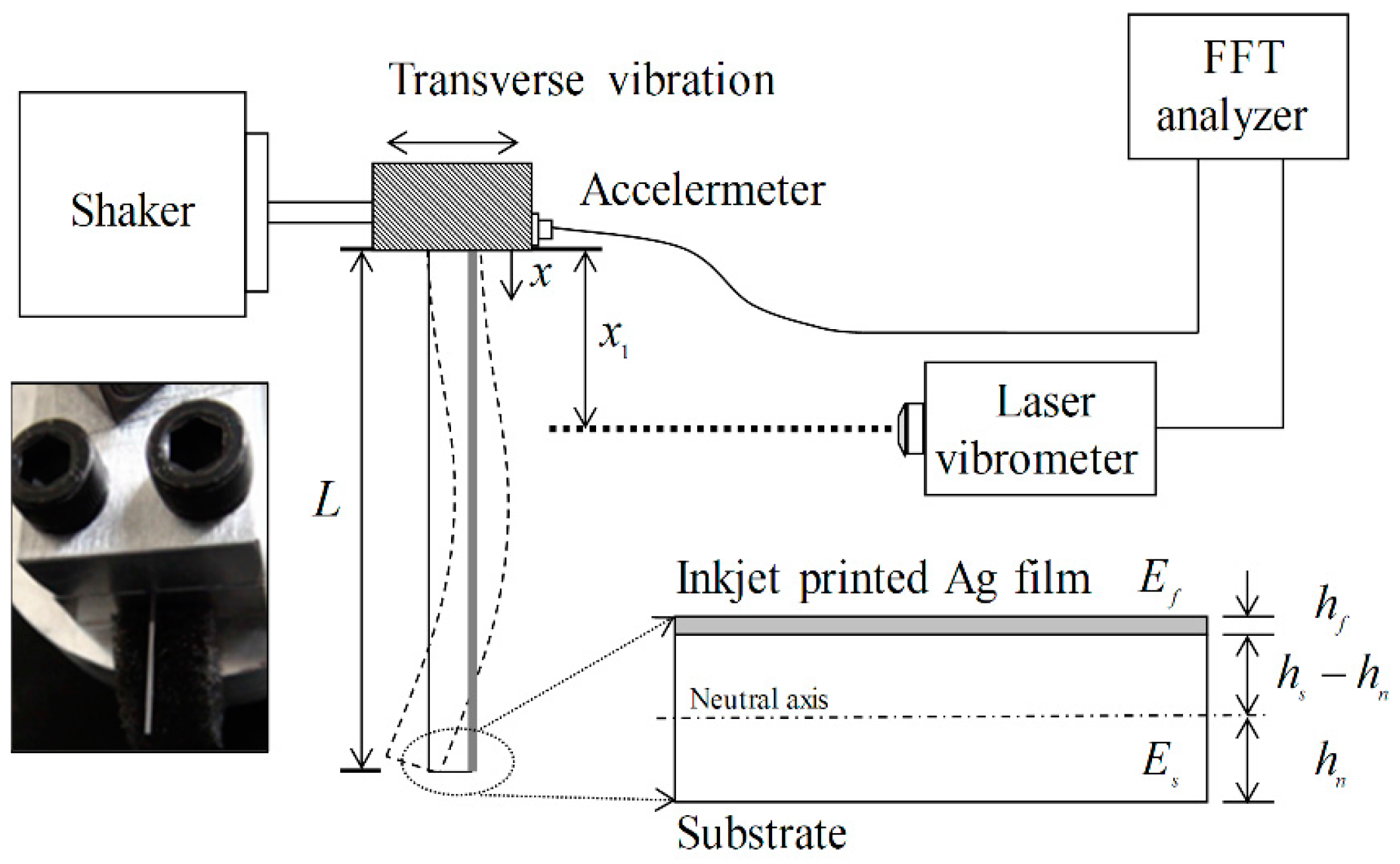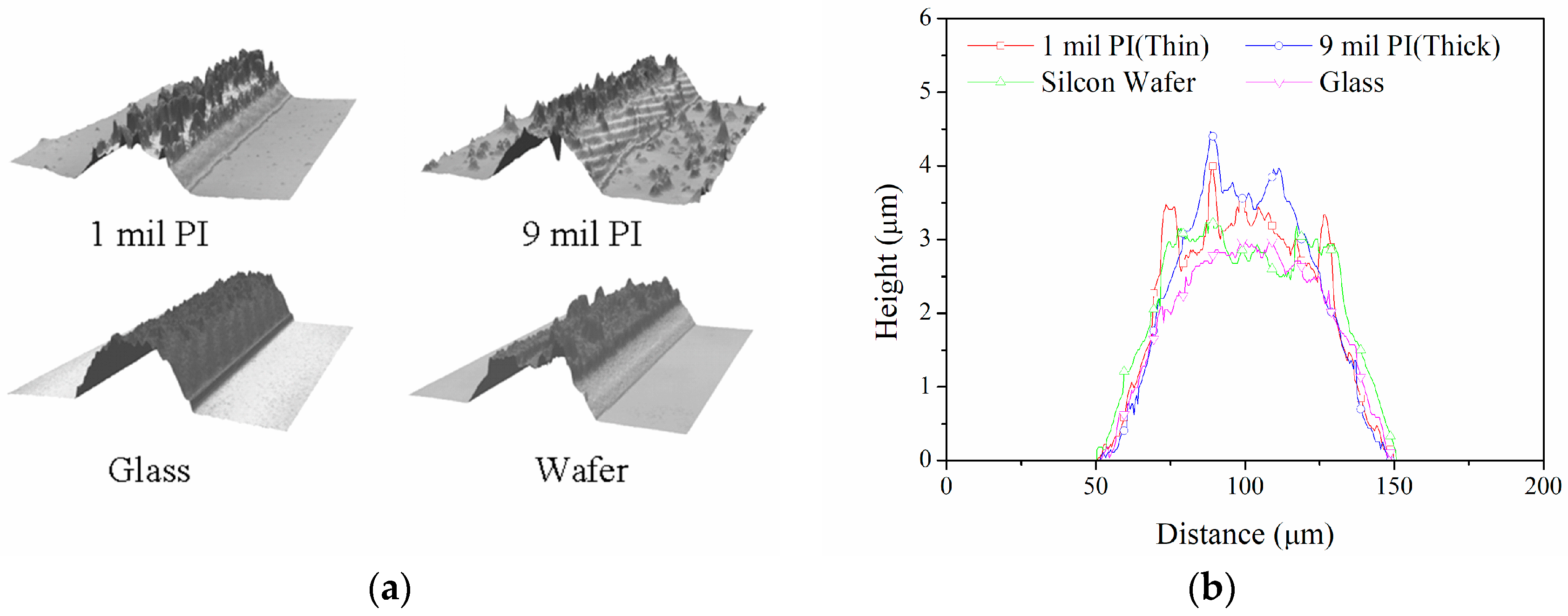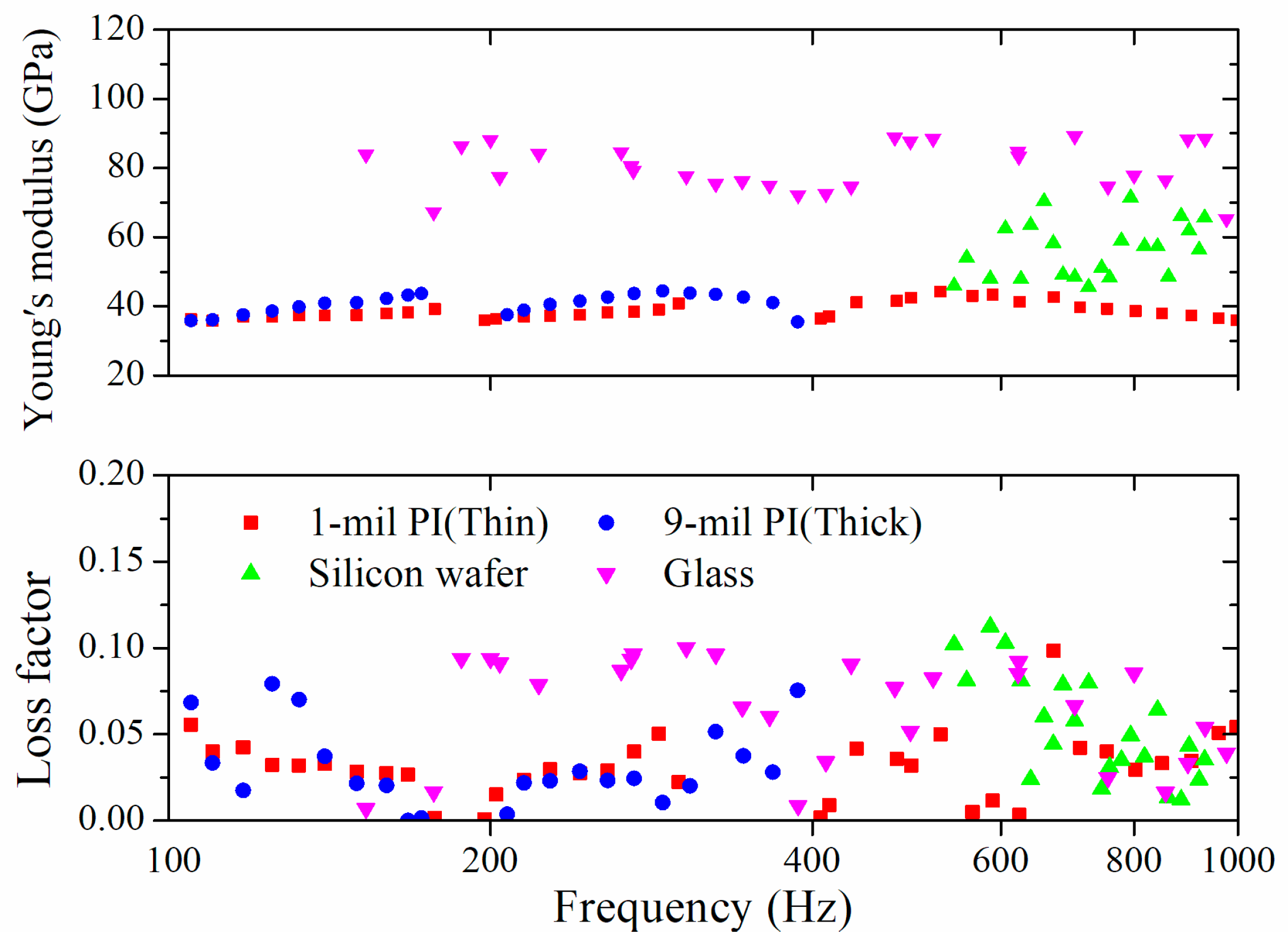Effect of Substrates on the Dynamic Properties of Inkjet-Printed Ag Thin Films
Abstract
:1. Introduction
2. Vibration Transfer of Ag Inkjet-Printed on Flexural Substrates
2.1. Flexural Wave Propagation of Inkjet-Printed Substrates
2.2. Bending Stiffness of the Bilayer Beams for Analyzing Vibrations on the Inkjet-Printed Ag Thin Films
3. Measuring the Dynamic Properties of Ag Ink on Flexural Substrates
3.1. Specimen Fabrication and Experimental Setup
3.2. Morphology and Characteristics of Ag Films
3.3. Dynamic Properties of the Ag Films
4. Conclusions
Acknowledgments
Author Contributions
Conflicts of Interest
References
- Kang, B.J.; Oh, J.H. Geometrical characterization of inkjet-printed conductive lines of nanosilver suspensions on a polymer substrate. Thin Solid Films 2010, 518, 2890–2896. [Google Scholar] [CrossRef]
- Wei, Z.; Chen, H.; Yan, K.; Yang, S. Inkjet printing and instant chemical transformation of a CH3NH3PbI3/Nanocarbon electrode and interface for planar perovskite solar cells. Angew. Chem. 2014, 126, 13455–13459. [Google Scholar] [CrossRef]
- Oh, J.H.; Lim, S.Y. Precise size control of inkjet-printed droplets on a flexible polymer substrate using plasma surface treatment. J. Micromech. Microeng. 2009, 20, 015030. [Google Scholar] [CrossRef]
- Wood, V.; Panzer, M.J.; Chen, J.; Bradley, M.S.; Halpert, J.E.; Bawendi, M.G.; Bulović, V. Inkjet-printed quantum dot–polymer composites for full-color AC-driven displays. Adv. Mater. 2009, 21, 2151–2155. [Google Scholar] [CrossRef]
- Graddage, N.; Chu, T.-Y.; Ding, H.; Py, C.; Dadvand, A.; Tao, Y. Inkjet printed thin and uniform dielectrics for capacitors and organic thin film transistors enabled by the coffee ring effect. Org. Electron. 2016, 29, 114–119. [Google Scholar] [CrossRef]
- Benight, S.J.; Wang, C.; Tok, J.B.; Bao, Z. Stretchable and self-healing polymers and devices for electronic skin. Prog. Polym. Sci. 2013, 38, 1961–1977. [Google Scholar] [CrossRef]
- Bai, J.G.; Creehan, K.D.; Kuhn, H.A. Inkjet printable nanosilver suspensions for enhanced sintering quality in rapid manufacturing. Nanotechnology 2007, 18, 185701. [Google Scholar] [CrossRef]
- Dong, H.; Carr, W.W.; Morris, J.F. An experimental study of drop-on-demand drop formation. Phys. Fluids 2006, 18, 072102. [Google Scholar] [CrossRef]
- Agarwala, S.; Yeong, W.Y. 3D printed electronic tracks for bio-integrated free-form devices. In Proceedings of the 2nd International Conference on Progress in Additive Manufacturing, Singapore, 16–19 May 2016. [Google Scholar]
- Zhang, L.; Wu, J.; Hedhili, M.N.; Yang, X.; Wang, P. Inkjet printing for direct micropatterning of a superhydrophobic surface: Toward biomimetic fog harvesting surfaces. J. Mater. Chem. A 2015, 3, 2844–2852. [Google Scholar] [CrossRef]
- Goh, G.L.; Ma, J.; Chua, K.L.F.; Shweta, A.; Yeong, W.Y.; Zhang, Y.P. Inkjet-printed patch antenna emitter for wireless communication application. Virtual Phys. Prototyp. 2016, 11, 289–294. [Google Scholar] [CrossRef]
- Andò, B.; Baglio, S.; Bulsara, A.R.; Marletta, V.; Ferrari, V.; Ferrari, M. A low-cost snap-through-buckling inkjet-printed device for vibrational energy harvesting. IEEE Sens. J. 2015, 15, 3209–3220. [Google Scholar] [CrossRef]
- Zhu, Q.; Fan, B. Low temperature sintering of 8YSZ electrolyte film for intermediate temperature solid oxide fuel cells. Solid State Ionics 2005, 176, 889–894. [Google Scholar] [CrossRef]
- Lee, D.J.; Oh, J.H. Inkjet printing of conductive Ag lines and their electrical and mechanical characterization. Thin Solid Films 2010, 518, 6352–6356. [Google Scholar] [CrossRef]
- Albert, A.D.; Becker, M.F.; Keto, J.W.; Kovar, D. Low temperature, pressure-assisted sintering of nanoparticulate silver films. Acta Mater. 2008, 56, 1820–1829. [Google Scholar] [CrossRef]
- Park, J.; Lee, D.J.; Kim, S.J.; Oh, J.H. Dynamic characteristics measurements of inkjet-printed thin films of nanosilver suspensions on a flexible plastic substrate. J. Micromech. Microeng. 2009, 19, 095021. [Google Scholar] [CrossRef]
- Greer, J.R.; Street, R.A. Mechanical characterization of solution-derived nanoparticle silver ink thin films. J. Appl. Phys. 2007, 101, 103529. [Google Scholar] [CrossRef]
- Wang, Y.; Sun, X.W.; Goh, G.K.L.; Demir, H.V.; Yu, H.Y. Influence of channel layer thickness on the electrical performances of inkjet-printed In-Ga-Zn oxide thin-film transistors. IEEE Trans. Electron Devices 2011, 58, 480–485. [Google Scholar] [CrossRef] [Green Version]
- Lee, D.J.; Oh, J.H.; Bae, H.S. Crack formation and substrate effects on electrical resistivity of inkjet-printed Ag lines. Mater. Lett. 2010, 64, 1069–1072. [Google Scholar] [CrossRef]
- Wang, W.-K.; Huang, S.-Y.; Jiang, M.-C.; Wuu, D.-S. Optoelectronic properties and structural characterization of GaN thick films on different substrates through pulsed laser deposition. Appl. Sci. 2017, 7, 87. [Google Scholar] [CrossRef]
- Oh, C.-S.; Lee, H.-J.; Ko, S.-G.; Kim, S.-W.; Ahn, H.-G. Comparison of the young’s modulus of polysilicon film by tensile testing and nanoindentation. Sens. Actuators A 2005, 117, 151–158. [Google Scholar] [CrossRef]
- Saha, R.; Nix, W.D. Effects of the substrate on the determination of thin film mechanical properties by nanoindentation. Acta Mater. 2002, 50, 23–38. [Google Scholar] [CrossRef]
- Li, X.; Bhushan, B. A review of nanoindentation continuous stiffness measurement technique and its applications. Mater. Charact. 2002, 48, 11–36. [Google Scholar] [CrossRef]
- Ozdoganlar, O.B.; Hansche, B.D.; Carne, T.G. Experimental modal analysis for microelectromechanical systems. Exp. Mech. 2005, 45, 498–506. [Google Scholar] [CrossRef]
- Burdess, J.S.; Harris, A.J.; Wood, D.; Pitcher, R.J.; Glennie, D. A system for the dynamic characterization of microstructures. J. Microelectromech. Syst. 1997, 6, 322–328. [Google Scholar] [CrossRef]
- Fahy, F.J. Sound and Structural Vibration: Radiation, Transmission and Response; Academic Press: Cambridge, MA, USA, 2012. [Google Scholar]
- Park, J. Transfer function methods to measure dynamic mechanical properties of complex structures. J. Sound Vib. 2005, 288, 57–79. [Google Scholar] [CrossRef]
- Hibbeler, R. Mechanics of Materials; Prentice Hall: Upper Saddle River, NJ, USA, 1997. [Google Scholar]
- Verver, M.M.; de Lange, R.; van Hoof, J.; Wismans, J.S. Aspects of seat modelling for seating comfort analysis. Appl. Ergon. 2005, 36, 33–42. [Google Scholar] [CrossRef] [PubMed]
- Park, J.-W.; Baek, S.-G. Thermal behavior of direct-printed lines of silver nanoparticles. Scr. Mater. 2006, 55, 1139–1142. [Google Scholar] [CrossRef]






© 2018 by the authors. Licensee MDPI, Basel, Switzerland. This article is an open access article distributed under the terms and conditions of the Creative Commons Attribution (CC BY) license (http://creativecommons.org/licenses/by/4.0/).
Share and Cite
Kim, D.; Kwak, Y.; Park, J. Effect of Substrates on the Dynamic Properties of Inkjet-Printed Ag Thin Films. Appl. Sci. 2018, 8, 195. https://doi.org/10.3390/app8020195
Kim D, Kwak Y, Park J. Effect of Substrates on the Dynamic Properties of Inkjet-Printed Ag Thin Films. Applied Sciences. 2018; 8(2):195. https://doi.org/10.3390/app8020195
Chicago/Turabian StyleKim, Deokman, Yunsang Kwak, and Junhong Park. 2018. "Effect of Substrates on the Dynamic Properties of Inkjet-Printed Ag Thin Films" Applied Sciences 8, no. 2: 195. https://doi.org/10.3390/app8020195




